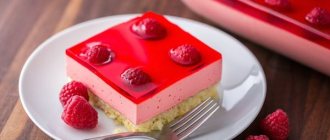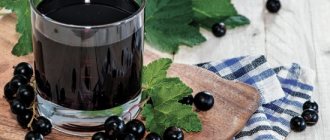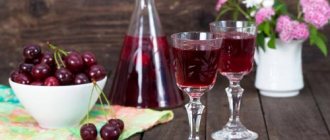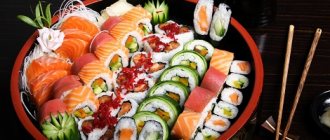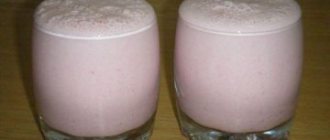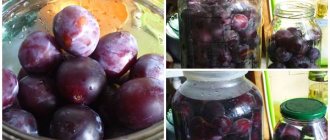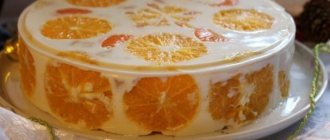Currant liqueur is a fragrant, bright drink that will decorate any holiday table. For home distillers and winemakers, currant berries are a godsend. It contains a sufficient amount of sugar necessary to obtain good wine, a lot of aroma and taste to obtain excellent liqueurs, liqueurs and tinctures. The cheapness of the berries allows you to even make currant moonshine at home.
Currant is a very healthy berry; it contains a large amount of various vitamins and amino acids. When making alcohol from currant berries, most of the beneficial substances are transferred into the drink. It follows that currant liqueur made at home has some healing properties that help fight various ailments.
Blackcurrant liqueur at home - a simple step-by-step recipe with vodka
You need to be especially careful with vodka for blackcurrant liqueur. It’s no secret that the so-called “knot”—alcohol distilled from wood waste—is often on sale.
Just don’t tell me that its chemical composition is identical to bread! There are differences, and significant ones, at the level of spatial molecular structure. Although the chemical formula written in the line is the same for ethyl alcohols obtained from different raw materials: C₂H₅OH. Therefore, you need to try to purchase real wheat vodka from trusted alcohol producers, and there are many of them.
Have you purchased it? Then let's look at the recipe for liqueur with whole berries, with the shell intact. Because there are also recipes for currant liqueur made from berries ground with sugar. This drink differs in color, consistency, and taste.
Ingredients:
- Wheat vodka – 0.5 l.
- Ripe currants – 500 g.
- Filtered water – 250 ml (1 faceted glass).
- Refined sugar – 250 g.
Note: Despite my justifiable dislike for refined sugar, this is what you need to use in this recipe. Any foreign inclusions inherent in unrefined sugar will only worsen the taste of the liqueur. The chemically purer the sugar, the better.
Preparing the liqueur:
1. Pour the sugar into a clean, well-sanded enamel bowl or into an equally clean food-grade stainless steel saucepan. Pour a glass of purified water and boil until the sugar crystals are completely dissolved. That is, cook the classic syrup for jam, without letting the sugar mass burn (the syrup should only have a slightly yellowish tint, remaining transparent).
Note: The remark about “tearing off” was not made in vain. If in the enamel bowl in which you started to cook the syrup, you have at least once prepared a fatty first or second course, or a fatty sauce, fat will definitely remain in the micropores of the enamel. No matter how thoroughly you wash the dishes after that. Therefore, the use of delicate abrasive agents, in combination with degreasing agents (“Fairy” and the like), before cooking the syrup is mandatory.
2. Sort out the currant berries. Remove the stalks and dry tails of the sepals at the end opposite the stalk. Only without violating the integrity of the berries. If you break the skin when tearing off a dry sepal, it is better not to use such a berry.
Dry sepals are cut off in cases where you don't want the tart, slightly astringent flavor of the liqueur - they contain tannins. By the way, you don’t have to tear them off, but cut them off with nail scissors, although this is a labor-intensive and tedious procedure.
3. Wait for the berry mass to boil until foam forms and switch the heat to low. Cook in this mode for 4 minutes, carefully removing the foam and melting the berries with a spoon.
4. Cool the blackcurrant syrup to room temperature, pour vodka into it, stir until evenly dissolved, maintaining equal proportions of liquid and berry mass, pour into bottles or jars.
5. Seal the containers tightly with reusable lids and place them in a cool place for 20-25 days, protecting them from light.
6. Twice a week, the containers with liqueur should be shaken or shaken in a circular motion.
7. At the end of 20-25 days, drain the resulting drink from the grounds and filter through a thick cotton-gauze filter with a throughput of approximately 100 ml per minute.
This liqueur can be guaranteed to be stored at room temperature for a year. If part of the wheat vodka is replaced with medical 96% alcohol, which increases the strength of the drink to 40% or more, then it will last longer, almost unlimitedly. Which, however, is unlikely to happen: the liqueur is very tasty.
Useful tips
Currant liqueur is a great addition to the holiday table. Many housewives have already written down a suitable recipe in a cookbook and use it every year. There are several tips that will allow you to prepare a truly tasty and aromatic alcoholic drink:
- It is better to choose overripe berries than green ones - the latter can not only turn out to be sour, but also cause poisoning;
- the quality of alcohol is crucial - you should not try to save money on this ingredient;
- During cooking, use only wooden spoons;
- alcohol tinctures are not suitable for treating children - it is better to prepare a decoction for them.
Currant liqueur will fully replace expensive imported liqueur. Another advantage is that you can add those seasonings and spices that you like, and also regulate the amount of sugar. In addition, this drink perfectly strengthens the immune system and will help fight seasonal infections.
How to make blackcurrant liqueur without vodka?
To immediately clarify, let’s put emphasis: “without vodka” does not mean without alcohol. Because “non-alcoholic liqueur” is the same oxymoron as non-alcoholic beer. Then make the syrup and don’t call it the noble word “liquor”.
But the product that comes out after implementing our recipe cannot be called currant wine either - it is too sweet for wine. So - liqueur. Weak, occupying the same niche as low-alcohol sweet liqueurs with a strength of 15 to 23⁰, which are served with coffee, tea and ice cream.
You can prepare such a drink fresh both in winter and in summer; fortunately, frozen currants are sold in supermarkets all year round. And for our purpose this will be quite suitable. The main thing is that during pre-sale storage in freezers it is not subject to thawing. Then things are bad, your product will probably turn sour.
And one more thing: currants that are frozen and thawed at home are slightly sour than fresh ones, keep this in mind. And the abundance of ascorbic acid released after freezing can slightly slow down the fermentation processes. Therefore, you will have to withstand the fermenting mass longer, and the sugar consumption will be 10 percent more.
Ingredients:
- Fresh or frozen currants – 2 kg.
- Granulated sugar – 750 g (800-850 for frozen).
- Boiled, cooled, settled water – 300 ml.
- Cinnamon or natural vanilla bean – 0.5 -1 g (at the final stage of preparation).
How to prepare low-alcohol liqueur:
The ingredients are selected for a 3-liter jar with a standard neck, over which you can pull a thin rubber or latex glove.
1. Sort the berries, remove leaves, blades of grass, and stalks. If it is possible not to wash, do not wash. This will significantly reduce the fermentation time of the berry mass.
2. Grind the berries in a meat grinder or submersible blender until you obtain a uniform mass of seeds, pulp, juice, and peel. Stir the resulting berry puree with sugar until it is completely dissolved. This will take several hours, stirring 2-3 times every hour.
An indicator of the correctness of such raw materials will be the solidification of crushed currants into a jelly-like mass some time after the final dissolution of sugar.
3. Pour in the prepared water. The jar should be 2/3 full. A maximum of ¾ of the volume should be accumulated after the start of the gas fermentation process. Stir the sweet berry mixture well in this water. The pulp should partially float and partially sink to the bottom. But during the fermentation process it will all rise up.
4. Put a rubber glove with a small hole in one of the fingers on the neck of the jar.
5. Place the jar in a warm place, maybe even under the sun’s rays. Fermentation under such conditions will last about 10 days, after which the glove will deflate - this will mean that all the berries involved in making the liqueur have basically fermented.
6. Drain the mixture through several layers of gauze into another jar. Squeeze out the pulp there (the pulp can then be thrown away). Start with cinnamon or vanilla in its natural form, that is, not ground into powder, and leave the resulting liquid to ferment under a rubber glove for another 2-3 days. After which the liqueur can be sealed with a tight lid and stored in a cool (10-15⁰C) place for about a month. All. The liqueur is ready. Now it is poured into suitable containers and served to the table.
If you want guaranteed safety of the drink for any long time, make it a little fortified, increasing the number of alcohol revolutions to 20-25% by adding pure alcohol or double-distilled and purified moonshine to the liquid. After adding strong alcohol in this case, you need to keep the liqueur for an additional 7-10 days after this procedure.
Features of use
It is worth remembering that, as with the consumption of other alcoholic beverages, moderation is also required here. It is better if the drink is drunk as an aperitif, that is, before eating. It is allowed to eat the tincture with light snacks.
But if a person experiences some problems with the functioning of the digestive organs, then you should not drink the drink on an empty stomach. Excessive amounts of acid can cause heartburn. Therefore, it is worth listening to the body when drinking a drink and adjusting it to individual needs.
And it’s worth remembering the catchphrase: “Alcohol does not lift your mood, but can only emphasize it, so you should drink only in a good mood.”
A simple recipe for blackcurrant liqueur with moonshine
Homemade moonshine, obtained from wheat wort, prepared for your own use, is a priori better than any purchased vodka. Unless, of course, you have a history of double distillation with cutting off the “heads” and “tails” (experts will understand what we’re talking about). And also double or triple purification from the inevitable companion of moonshine distillation - acetone, as well as aldehydes, phenols and fusel oils.
At least you know what it was made from. How and to what extent it was purified and how many degrees there will be in your intended liqueur. That is, what will be the output: strong, with a low sugar content, medium, with an average sugar percentage, or weak, dessert and very sweet. But in all cases it is very tasty and safe.
You know, there is such a type of product: not the first, not the highest, but “for yourself” - that is, the best!
About currants. For the tincture, choose the largest berries within the variety that you use for liqueur. In the largest fruits on a bush or in a bunch, the maximum aroma and all the substances inherent in both currants in general and the selected variety are concentrated.
Ingredients:
- Ripe sorted currants – 1 kg.
- Currant leaves (black, no other will do!) - 4-5 pcs.
- Moonshine double distilled and purified – 1.5 l.
- Brown cane sugar – 1 kg.
- Purified filtered water – 250-300 ml (optional)
Preparation:
The sugar in the recipe is brown, which should not confuse you. The fact is that substances that color cane sugar play the role of sorbents, effectively purifying moonshine from fusel oils and other harmful substances that still remain after distillation and purification.
To infuse the liqueur, it is better to take a bottle with a moderately wide neck and with such a volume that, filled with all the ingredients, there remains at least 1/3 of free space.
1. Wash the bottle, let the water drain, and dry it.
2. Sprinkle a small layer of sugar on the bottom, then a layer of berries. Again a layer of sugar - a layer of berries - and so on until both are used up. Do not mix the layers, do not shake the bottle! In this form, place it in a dark place at room temperature for exactly three days. During this time, the berries in contact with sugar will inevitably produce juice.
3. At the end of three days, pour all the prepared moonshine into the bottle. There should be enough of it so that the berries are covered with liquid by 2-3 cm.
4. Close the vessel with a lid to prevent alcohol vapors from escaping, which will inevitably reduce the strength of the drink. Shake (now you can!), mixing the moonshine and layers of berries with not completely dissolved sugar, and leave it like that for two months. Twice a week the contents of the bottle should be shaken and shaken. You will see how the drink will gradually begin to turn from barely colored into a thick purple-red.
5. At the end of this period, drain the liqueur, strain the berries, and then filter several times through a thick cotton-gauze filter. The final filtration (if you have the patience) can be done through chemical filter paper. Then the drink will be crystal clear, with a red-violet color.
6. Pour into dark glass bottles for storage and seal tightly.
Important! The recipe lists water as an optional ingredient. It serves only to lower the strength of the pouring, given that the usual strength of moonshine of the second distillation, after cutting off the “head” and “tails” is from 60 to 75⁰. It is slightly reduced by the juice released during the infusion process. But still, even 45 degrees for pouring is too much. In this regard, the amount of sugar stated in the recipe can be increased to 1.2 kg.
Double pour with honey
The birthplace of this recipe is Poland, and therefore it will not be possible to do without honey. It will add a subtle floral aftertaste to the drink. You will need to take:
- 500 ml each of vodka and alcohol;
- 1 kg of berries;
- 400 grams of granulated sugar;
- honey to taste.
A blackcurrant liqueur is prepared using alcohol and vodka as follows:
- Rinse the berries, put them in a bottle and fill them with alcohol, mix everything and seal it. Leave for 30 days in the basement or cellar.
- Pass the resulting alcohol base through a cotton-gauze filter and pour into another container. Close the lid and leave for another week.
- Sprinkle the separated cake with sugar, cover and leave for another 10 days.
- Pass the resulting sweet syrup through a filter and combine with alcohol.
- Add honey and leave again for a week.
- Strain and bottle.
Put it in a cellar or basement for a couple of months. The drink is ready to drink, but it is best served with ice or pre-chilled. By the way, adding honey always makes any alcohol noble.
Homemade currant liqueur with alcohol "Dragon's Tear"
You can dismiss such a recipe with disdain: “Well, you have to use alcohol!” What else is this for? And you ask perfumers: why do they make infusions of their fragrances not with a 40-degree alcoholic composition, but with something that burns with a blue flame? They will answer you that it is in alcohol that all aromatic esters are most fully preserved and that they smell better and sharper. It’s the same story with taste, as well as with the aroma of an alcoholic drink during its consumption.
In addition, by consuming such drinks correctly, you can restore your health to normal. Only, of course, very, very in moderation. It is not without reason that at all times the consequences of heavy, extreme physical exertion (including emotional ones) were removed with a 100-gram dose of alcohol.
Just no more - otherwise the medicine turns into poison. And so, in moderation, and even with sleep after that, alcohol taken orally completely burned the main symptom of fatigue - lactic acid accumulated in the muscles. At the same time, he himself burned without a trace and without consequences in the form of a hangover syndrome; mutual neutralization of these antagonists occurred.
We bring to your attention an alcohol tincture with the exotic name “Dragon’s Tear”.
Ingredients for alcohol tincture:
- Black currant – 1 kg.
- Medical alcohol - 1 liter of 76% strength, or 0.75 liter of 96% strength.
- Purified water: 200 ml for 76% alcohol or 400 ml for 96% alcohol.
- Brown sugar: for 76% alcohol - 500 g, for 96% alcohol - 700 g.
- Black currant leaves – 5-6 pcs.
In any case, the strength of the base should not be lower than 65% alcohol content.
Water is not poured into alcohol as a diluent - it is used at the stage of cooking the simplest, unsaturated syrup. With this procedure, brown sugar becomes more chemically active, it more easily enters into the necessary purification reactions with alcohol.
Preparation:
1. Pour the prepared water into the measured sugar. Melt over low heat so that the sugar does not burn (stirring additionally). The syrup should be cooked in a clean enamel pan or in a food-grade stainless steel bowl. Determine the amount of water (and therefore the future strength) right away in order to measure the required amount of sugar.
2. Pour currants into the boiling syrup and stir, lifting them with a spoon or spatula from below, and not submerging them - this way the berries will remain intact.
3. Boil for 5 minutes, skimming off the foam, then remove from heat and cool to room temperature.
4. Pour alcohol into this “undercooked jam”, stir with a wooden spoon until the berry syrup in the base is completely and evenly dispersed. Pour the resulting mixture into a glass bottle and seal it hermetically with sealing wax or wax.
5. Place the jar in a dark room where daylight, and especially direct sunlight, does not penetrate. Leave for at least three weeks (or better yet, a month), periodically, 2 times a week, shaking.
6. After the holding period has expired, mix everything well and strain through a sieve, removing the largest fragments. And then filter several times with any homemade filter. The best results are obtained with a filter with a throughput of no more than 100 ml per minute. Only after every 100 ml does the filter need to be changed by squeezing the liquid into the still unfiltered part (because the filter will be clogged).
7. The last stage is ripening. After filtration, the containers with the filling are placed for a week in a cool place (from 4 to 10⁰C, possibly in the NOT freezer compartment of the refrigerator) in sealed containers. After this aging, the liqueur can be filtered for the last time and served.
This liqueur is stored without changing its taste and properties for at least 3 years.
Product storage rules
The duration of storage is determined by the production technology and correct storage:
- Bottles must be tightly sealed. Some even use sealing wax over the cork.
- Next, you should avoid direct sunlight on the drink. In principle, even a simply lit room is not entirely suitable for preserving the qualities and healing properties of the drink.
- It is better to choose a dark, cool place, so the drink will last for approximately 3-8 months, depending on the preparation method.
- If the drink is boiled at the stage of mixing berries and sugar, then this tincture will be stored for more than a year, but it is better to put it in the refrigerator.
